
Using the ME-61 on 6 Meters
A
"reversible" mod to extend the range of the ME-61.
A
simple frequency coverage mod for 29.0
and
51.0
Mcs.
The
ME-61 Field Strength Meter.
5-7 turn coil
The simple mod. A 30 minute project. Which will increase the sensitivity of the ME-61 on 29.0 and 51.0. Mc. More info below.

The ME-61 has a design frequency range that covers up to 24 Mcs. Band 3 is designed to cover 10 to 24 Mcs. The "reversible" modification will change the coverage of Band 3 to a higher frequency range.
Q.
Will the ME-61 give a relative indication on 29 and 51 Mc without modification?
Ans: Yes when measuring higher power levels if you set the ME-61 tuning control to 24 you will get a reading.
Q. The reading that I obtain - is it usable?
Ans. Depends. Most field strength readings for the purpose of antenna tuning particularly in the VHF range require as much separation as possible between the transmitter antenna and the field strength meter to be reliable. At low power levels the ME-61 is not sensitive enough and can not provide this.
Q. Can the ME-61 (unmodified) be used for antenna tuning on low power radios such as the PRC-6?
Ans: With VHF power levels less than 1 watt the ME-61 is fairly useless when tuning the antenna system as you have very little separation between the transmitter antenna and the ME-61 antenna. Best results occur when separation distance between the transmitter and the field strength meter is as far as possible.
Q.
I've found that the ME-61 is not very sensitive even on its designed
operational range. Is there anything I can do?
Ans:
Improvement of sensitivity can be obtained by changing the 1 Ma meter
to a more sensitive meter or adding a internal amplifier. See link below.
http://k4che.com/ME-61/ME-61.htm

These "low power" radios on 51.0 Mc utilize field strength when aligning the antenna section. At low transmit powers the stock ME-61 will not allow accurate field strength measurements as you can not get far enough away from the transmitter antenna and the operators body gets in the way as well as near by objects.
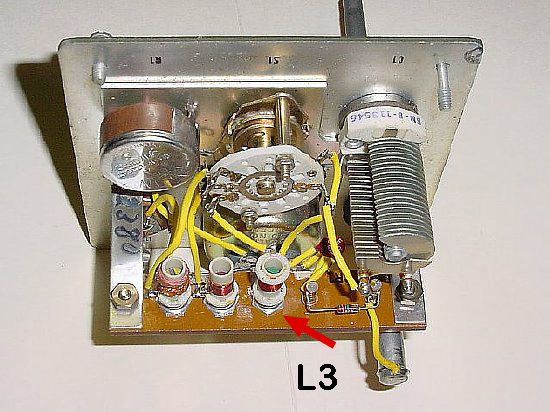
ME-61
chassis
The
rotary switch selects each band coil and has 3 band positions. The variable
capacitor allows tuning across the selected band. A 50 K pot controls
sensitivity. The mod will effect coil L3 and change the frequency coverage
of 10 to 24 Mc to a higher range to cover 10 and 6 meters.
Note: The unofficial military equipment collectors FM calling frequencies are 29.4 and 51.0.
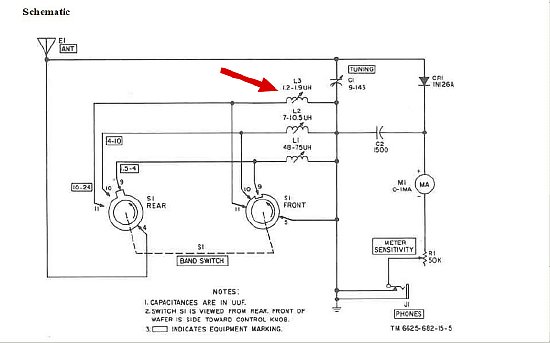
CLICK
to enlarge
Band
3 coil has an inductance of 1.2 to 1.9 uH and is adjustable.
Lowering
the inductance value of L3 will raise the frequency coverage of band 3.
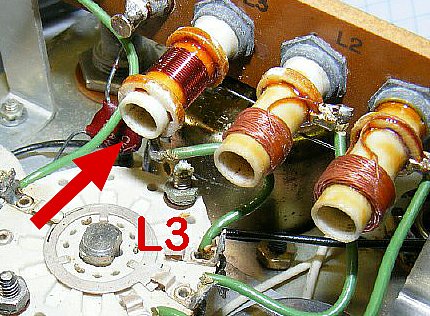
Bench tests tuning of L3
During Bench Testing L3 was adjusted to minimum inductance. The meter frequency coverage was extended to 45 Mc but would not cover 51.0 However the meter would cover 10 meter (29.6) So-sorrie G.I. No workee on 6. Further modification of L3 would be necessary for proper 51.0 coverage.
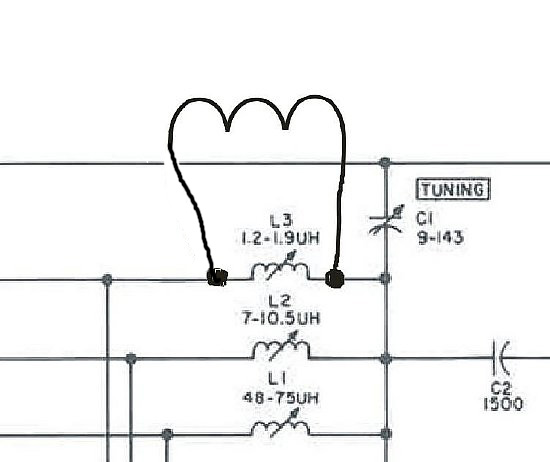
Lowering
the inductance of L3 will raise the frequency coverage.
And
easy way to lower the inductance of L3 is to add an additional coil in
parallel. This coil can be soldered across the existing L3 coil and can
be removed readily. The mod is easily reversed and L3 and its original
tuning are left as is.
A
simple solution. Add a coil in parallel.
The
inductance of L3 is 1.2 to 1.9 uH or about 1.5 uH average. So adding a
smaller value in parallel will reduce the overall inductance and raise
the frequency coverage.
TIP: When working with coils in parallel the total inductance of the the parallel combination will always be LESS than the smallest inductance that is wired in parallel.

Wind
a 5 to 7 turn coil.
Take
some enamel covered wire OR any insulated wire and wind a coil on the
1/4 inch drill bit or just use a pencil. In the example shown above a
5 turn coil was utilized. It takes about 8 inches of #20 enamel wire.
WIRE size is not critical,
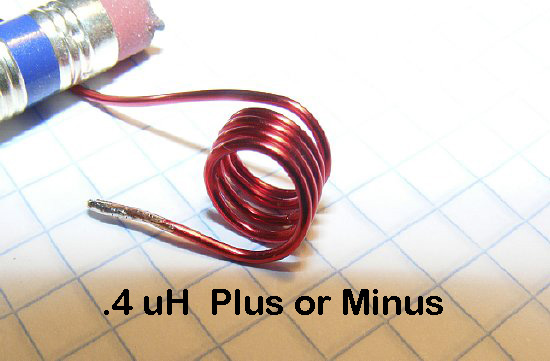
The "measured" inductance was approximately .4 uH. Its hard to measure very small inductance value.

Try out this formula
for total inductance's of two (2) parallel coils.
Use the values of
1.5uH (ME-61 original coil) and .4 uH the modification coil.
Answer: .31 uH. Note that the final inductance is smaller thatn the smaller .4 coil.

And
now to compute the resonant frequency using the value of .31uH and the
ME-61 variable capicator which varies between 9 and 143 pf. Stop wasting
time and just go to :
http://www.deephaven.co.uk/lc.html
The computed resonance for the above are 90 Mcs and 24 Mc so as estimated range for the ME-61 with the coil mod is 24 to 90 Mc which more than covers 6 and 10 meters. My meter the coverage was a lot less so a slight error must have been made in the measurement of the inductance.

7 Turn coil
The modification coil of 6-7turns can be compressed or expanded to raise or lower frequency. Its not exactly "Rocket Science" try it. Coil shown above gave coverage from 24 Mc to 70 Mc.
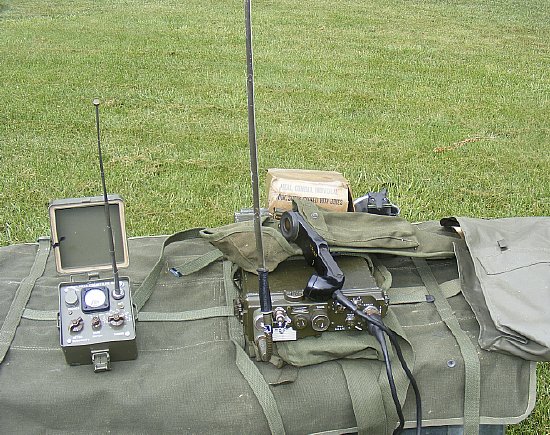
All though antenna tuning is not needed on the PRC-10 confirming a active antenna mount on the PRC-10 is very important. Most ham hacked PRC-10's have errors in the Long Ant and Short Ant front panel antenna wiring and the antennas are not connected properly to internal loading coils.